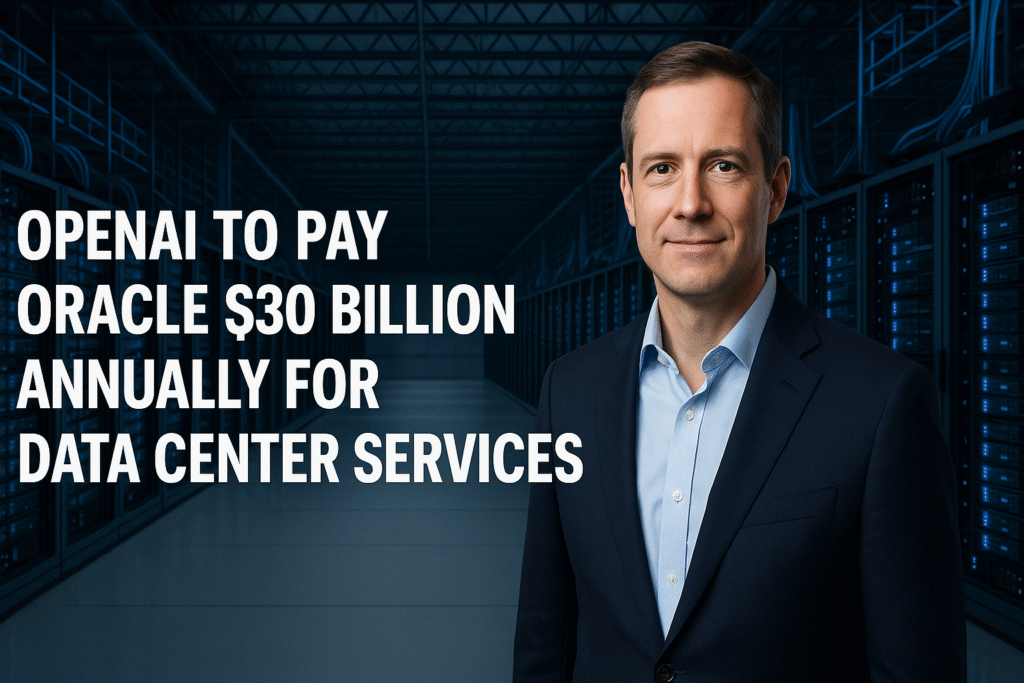OpenAI to Pay Oracle $30 Billion Annually for Massive AI Data Center Services

1. What’s the Deal?
- Contract Value & Scope: OpenAI has signed an agreement to lease 4.5 gigawatts of data center capacity from Oracle, with an estimated annual cost of $30 billion.
- Timeline: The contract is set to begin in fiscal year 2028 as part of a multi-year partnership aligned with OpenAI’s ambitious “Stargate” infrastructure rollout.
- Scale Reference: 4.5 GW is enough to power four large nuclear plants—representing around 25% of the total U.S. data center capacity.
2. Background — The Stargate Initiative
- Launch: Stargate was announced in early 2025 as a $500 billion AI super-infrastructure initiative involving OpenAI, Oracle, SoftBank, and MGX.
- Objective: Build over 10 gigawatts of AI-dedicated data centers across the U.S., supporting the next generation of AI research and deployment.
- Equity Split: OpenAI and SoftBank each hold a 40% stake, while Oracle and MGX share the remainder.
3. What Oracle Will Build
- Facilities: Expansion of existing Oracle sites, such as the Abilene, Texas campus (from 1.2 GW to nearly 2 GW), plus new campuses in multiple states including Michigan, Wisconsin, Georgia, and Ohio.
- Tech Infrastructure: Oracle will deploy hundreds of thousands of NVIDIA GB200 AI chips, advanced cooling systems, high-voltage DC distribution, and ultra-fast fiber networking.
- Operational Goals: Texas data center expected to go live by mid-2026, with full rollout aligning with the contract start in 2028.
4. Why This Matters
🌐 For OpenAI:
- Secures long-term, reliable access to compute resources critical for training large-scale AI models.
- Reduces dependence on Microsoft Azure or GPU supply chain volatility.
🚀 For Oracle:
- Establishes Oracle as a major player in AI infrastructure, potentially tripling its cloud revenue.
- Significantly enhances its relevance in the rapidly evolving AI space.
🔄 For the Industry:
- Could prompt counter-moves from rivals like Microsoft, AWS, and Google Cloud.
- Reinforces the shift toward vertically integrated AI infrastructure providers.
- Strengthens U.S. leadership in AI infrastructure development.
5. Challenges & Concerns
- Execution Risk: Building and connecting such massive infrastructure across multiple states requires major coordination with utilities and local governments.
- Environmental Impact: Operating 4.5 GW of data centers could consume over 30 terawatt-hours of electricity per year—raising pressure to source clean energy and mitigate carbon emissions.
- Financial Load: Oracle’s massive planned investment in GPUs and facilities could strain short-term financials, increasing capital spending to historic levels.
6. Geopolitical & Corporate Dynamics
- SoftBank Tensions: Reports suggest friction between OpenAI and SoftBank, possibly leading to more emphasis on Oracle-led infrastructure over other Stargate sites.
- U.S. Tech Strategy: The deal aligns with American goals to localize and secure AI infrastructure, ensuring national competitiveness against global tech powers like China.
7. What’s Next?
| Timeline | Milestone |
|---|---|
| 2025 | Site approvals and construction kick off; GPU and server procurement begins |
| 2026 | Initial facilities (like Texas) expected to become operational |
| 2028 | Full-scale Oracle services under the $30B/year contract begin |
| 2029 | Stargate aims to cross 10 GW total capacity across U.S. sites |
8. Final Thoughts
This groundbreaking $30 billion-a-year agreement between OpenAI and Oracle marks a watershed moment in the evolution of AI infrastructure:
- For OpenAI, it ensures a steady path to scale future models without compute limitations.
- For Oracle, it’s a bold transformation into a top-tier AI cloud services provider.
- For the tech world, it sets a new precedent in AI infrastructure strategy—massive, vertically integrated, and deeply interwoven with national priorities.
The success of this deal hinges not just on hardware delivery, but on execution, sustainability, and global competitiveness in the era of artificial general intelligence (AGI).

